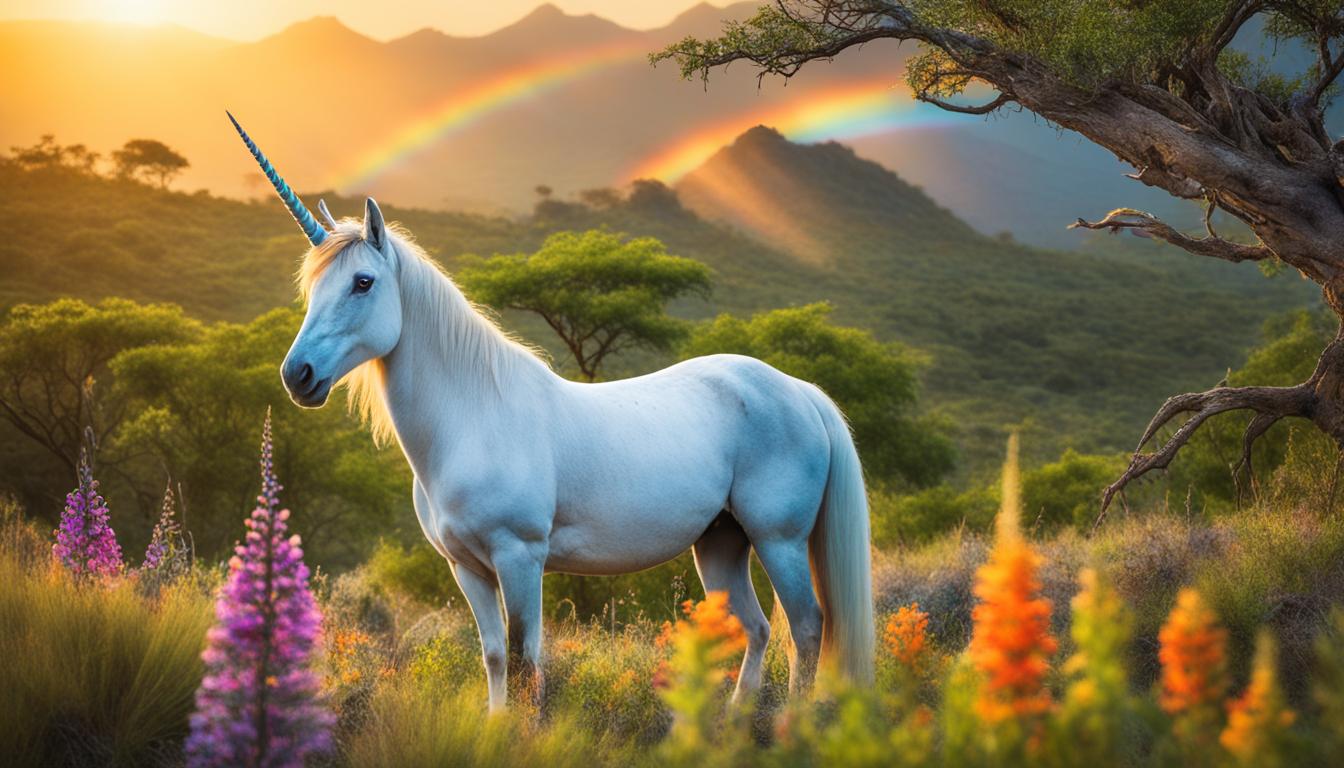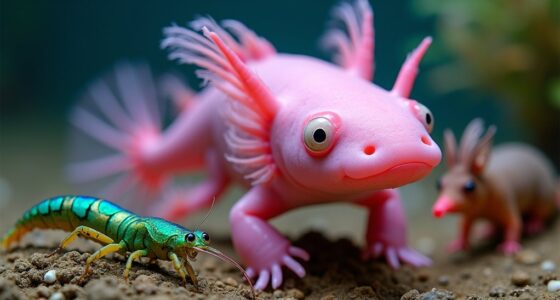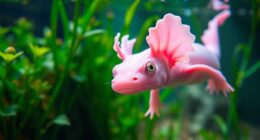Did you know that there are intriguing creatures out there, with names starting with the letter U? From stunning birds to nimble animals, these one-of-a-kind creatures celebrate the variety of our planet’s wildlife. Let’s delve deeper into some exceptional animals that begin with U and discover the marvels of the natural world.
Key Takeaways:
- Animals that start with U showcase the incredible diversity of the animal kingdom.
- Discover fascinating creatures like uakaris, Uinta chipmunks, and Uluguru violet-backed sunbirds.
- Exploring these unique animals reminds us of the importance of conservation efforts to protect their habitats.
- From South America to Australia, these animals can be found in various regions around the world.
- Stay tuned to learn more about these extraordinary creatures that make up our natural world.
Uakari
Uakaris are fascinating monkeys belonging to the genus Cacajao, found in the lush rainforests of South America. These unique primates are known for their distinctive appearance, characterized by bald heads, long shaggy coats, and relatively short tails. With their captivating features, uakaris stand out among the diverse primate species in their range.
There are four recognized species of uakaris:
- Bald Uakari
- Golden-backed/Black-headed Uakari
- Aracá Uakari
- Neblina Uakari
Each species showcases its own distinct coloration and physical characteristics, contributing to the vibrant biodiversity of South America’s primate population.
Uakaris belong to the family Pitheciidae, which includes several other monkey species native to the region. These primates play vital roles in the ecosystem as seed dispersers, helping in the regeneration and survival of the rainforest flora.
Uakari Facts at a Glance
| Scientific Name | Genus | Family | Region |
|---|---|---|---|
| Cacajao | Monkey | Pitheciidae | South America |
Uinta Chipmunk
The Uinta chipmunk is a medium-sized rodent found in mountainous forests in western North America. This adorable creature, also known as Tamias umbrinus, is a member of the squirrel family, Sciuridae. It has a reddish-brown coat with distinctive white stripes across its face and back.
The Uinta chipmunk is native to the Uinta Mountains in northeastern Utah, but it can also be found in parts of Colorado, Wyoming, and Idaho. This small mammal is well-adapted to its mountainous habitat and is often seen scurrying along the forest floor or climbing trees in search of food.
Like other chipmunks, the Uinta chipmunk is diurnal, meaning it is most active during the day. It is an omnivorous creature, feeding on a variety of foods including nuts, seeds, berries, insects, and even bird eggs.
Features of the Uinta Chipmunk:
- Medium-sized rodent
- Reddish-brown coat with white stripes
- Belongs to the squirrel family, Sciuridae
- Found in mountainous forests in western North America
- Diurnal and omnivorous
The Uinta chipmunk is a captivating mammal that adds charm and excitement to the North American forests. With its vibrant coat and playful nature, it is a joy to observe in its natural habitat.
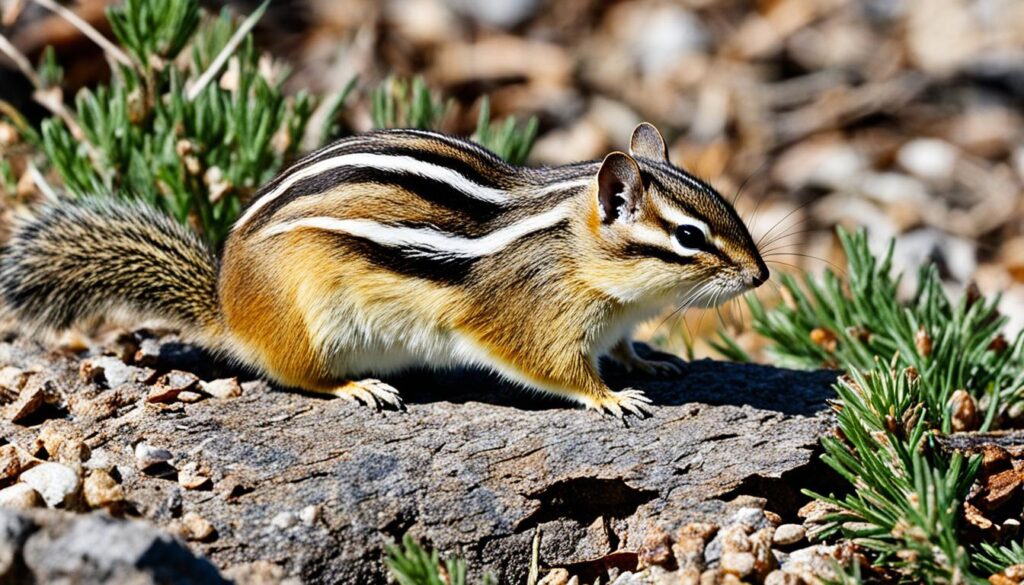
Comparison Table: Uinta Chipmunk vs. Western Gray Squirrel
| Features | Uinta Chipmunk | Western Gray Squirrel |
|---|---|---|
| Size | Medium | Large |
| Coat Color | Reddish-brown with white stripes | Gray |
| Habitat | Mountainous forests | Wooded areas |
| Range | Western North America | Western United States |
| Activity | Diurnal | Diurnal |
Ultimate Shrew
The ultimate shrew, a small mammal native to the montane tropical forests of Kenya in Africa, is a fascinating creature to behold. Belonging to the shrew family, Soricidae, it shares close kinship with other remarkable animals such as hedgehogs, moles, and solenodons. With its unique characteristics and adaptations, the ultimate shrew has carved a niche for itself in the diverse ecosystem of Africa.

“Discovering the ultimate shrew in its natural habitat is akin to stumbling upon a hidden gem. This creature’s resilience and resourcefulness in the face of challenging environments truly captivate the imagination.”
The ultimate shrew is expertly adapted to thrive in the montane tropical forests. Its small size, compact body, and agility enable it to navigate through dense vegetation with ease. It possesses a keen sense of smell, which aids in hunting prey and detecting potential predators. Despite its diminutive stature, the ultimate shrew plays a vital role in maintaining the delicate balance of the forest ecosystem. As an insectivore, it feeds on a variety of small invertebrates, including insects, spiders, and worms. By controlling the population of these creatures, the shrew indirectly contributes to the overall health and stability of the forest. Understanding the ultimate shrew’s behavior and ecological significance requires further research and conservation efforts. With the ongoing threat of habitat loss and fragmentation, protecting the montane tropical forests of Africa is crucial for the survival of this unique species and the preservation of biodiversity.
Fun Facts about the Ultimate Shrew:
- The ultimate shrew is primarily nocturnal, emerging under the cover of darkness to forage for food.
- It communicates using a combination of high-pitched vocalizations and scent marking.
- The shrew has a rapid metabolism, requiring it to consume a significant amount of food compared to its body weight.
Conservation Status of the Ultimate Shrew:
| Population | Status |
|---|---|
| Stable | Least Concern |
Despite the ultimate shrew’s stable population and current least concern conservation status, proactive measures are necessary to safeguard its habitat and ensure its long-term survival. Collaborative efforts between local communities, conservation organizations, and government agencies are essential to protect the montane tropical forests and the unique wildlife they harbor.
Uluguru Violet-Backed Sunbird
The Uluguru violet-backed sunbird is a small bird found in East Africa. Its vibrant iridescent plumage, ranging from purple to blue, is a captivating sight to behold. This stunning bird belongs to the family Nectariniidae, a group of birds commonly known as sunbirds.
The Uluguru violet-backed sunbird is part of a superspecies that includes three other closely related species. These birds share similar physical characteristics and behaviors, but each species has its own unique distribution and habitat preferences.
The Uluguru violet-backed sunbird is known for its nectar-feeding behavior, using its long, curved beak to sip the sweet nectar from flowers. It plays a vital role in pollination as it moves from one flower to another carrying pollen on its beak and feathers.
Features of the Uluguru Violet-Backed Sunbird:
- Size: Small
- Plumage: Iridescent purple-blue
- Habitat: East Africa
These captivating birds primarily inhabit forests and woodland areas, where their colorful plumage provides camouflage among the vegetation. They can be found in countries such as Tanzania, Kenya, and Mozambique, adding a touch of beauty to the African landscape.
Whether you spot the Uluguru violet-backed sunbird darting through the trees or hovering near a flowering plant, its presence is sure to leave a lasting impression. This bird serves as a reminder of the remarkable diversity of birdlife in Africa and the importance of preserving their natural habitats.

| Common Name | Scientific Name | Distribution |
|---|---|---|
| Uluguru violet-backed sunbird | Cinnyris elgonensis | Eastern Africa |
| Superb Sunbird | Cinnyris superbus | Sub-Saharan Africa |
| Purple-banded Sunbird | Cinnyris bifasciatus | Eastern and Southern Africa |
| Splendid Sunbird | Cinnyris coccinigaster | Sub-Saharan Africa |
Ulysses Butterfly
The Ulysses butterfly is a magnificent insect that captures the attention of anyone fortunate enough to witness its vibrant beauty. Found in Australia and nearby islands, this large butterfly belongs to the Papilionidae family, which includes some of the most striking butterflies in the world.

What sets the Ulysses butterfly apart is its brilliant blue coloration, which adorns its delicate wings. The intense blue hue is truly eye-catching and makes this butterfly a favorite among nature enthusiasts and photographers.
The Ulysses butterfly showcases elongated hindwings, further enhancing its graceful appearance as it flutters through the landscapes of Australia. Its impressive wingspan and intricate patterns make it a sight to behold, symbolizing the beauty and wonders of the insect world.
The natural habitat of the Ulysses butterfly includes tropical rainforests and coastal regions, where it is often found near its larval food plants, such as the pink-flowered Mischantus luteus. Its presence in these areas is a testament to the importance of preserving the environment and protecting the delicate ecosystems that support such remarkable creatures.
A Symbol of Conservation
“The Ulysses butterfly serves as a reminder of the incredible diversity of life on our planet and the crucial role we play in its preservation.”
As an integral part of the rich biodiversity in Australia, the Ulysses butterfly serves as a symbol of conservation. Its existence highlights the need to protect and restore natural habitats for insects and other wildlife. By safeguarding the environments that sustain these enchanting creatures, we ensure their survival for generations to come.
Appreciating Nature’s Artistry
The Ulysses butterfly invites us to pause and appreciate the artistry of nature. Its vivid blue coloration, intricate wing patterns, and graceful flight serve as a source of inspiration and wonder. By immersing ourselves in these natural wonders, we gain a deeper understanding of the intricate web of life and the interconnectedness of all living beings.
Key Features of the Ulysses Butterfly
| Scientific Name | Papilio ulysses |
|---|---|
| Family | Papilionidae |
| Location | Australia and nearby islands |
| Wingspan | Up to 6 inches |
| Main Color | Bright blue |
| Habitat | Tropical rainforests and coastal regions |
| Food Plants | Pink-flowered Mischantus luteus |
Through its striking appearance and ecological significance, the Ulysses butterfly captivates our imagination and ignites a sense of awe for the natural world. As we continue to explore and protect the unique creatures that inhabit our planet, we ensure a harmonious coexistence with the diverse ecosystems that make our Earth a truly remarkable place.
Umbrellabird
Umbrellabirds are remarkable and mid to large-sized birds known for their distinctive umbrella-like crests. Belonging to the family Cotingidae, these birds can be found in the lush rainforests of Central and South America.

With their fascinating appearance and unique features, umbrellabirds have captured the attention of bird enthusiasts and researchers alike. Their name stems from the elaborate crests on their heads, which resemble the shape of umbrellas, and are more prominent in males.
“The umbrellabird’s crest is truly a remarkable feature, setting it apart from other avian species in the region,” says Dr. Maria Hernandez, a renowned ornithologist specializing in South American bird species.
These birds play an important role in maintaining the delicate balance of the ecosystems they inhabit. Known for their frugivorous diet, umbrellabirds primarily feed on fruits, making them important dispersers of seeds, contributing to forest regeneration.
Distinctive Characteristics of Umbrellabirds
Umbrellabirds possess several distinguishing features that set them apart from other birds:
- The males’ umbrella-like crest, which can reach up to half the length of their body.
- Females have a crest as well, although it is smaller and less elaborate.
- They have broad wings and a short, rounded tail.
- Their plumage is predominantly black, with a glossy sheen.
The combination of these characteristics creates a visually striking and captivating bird species that showcases the wonders of nature.
| Common Name | Scientific Name | Location | Status |
|---|---|---|---|
| Bare-necked umbrellabird | Cephalopterus glabricollis | Costa Rica, Panama | Near Threatened |
| Long-wattled umbrellabird | Cephalopterus penduliger | Colombia, Ecuador | Endangered |
| Amazonian umbrellabird | Cephalopterus ornatus | Brazil, Peru | Vulnerable |
These extraordinary birds play a crucial role in maintaining the biodiversity of their habitats. By spreading seeds and contributing to forest growth, they help to sustain the delicate balance of Central and South American ecosystems.
In conclusion, umbrellabirds are not only captivating due to their unique crests but also play a significant ecological role. Their presence in the rainforests of Central and South America reminds us of the incredible diversity and beauty found in the avian world.
Uganda Kob
The Uganda kob, a subspecies of the kob antelope, is a magnificent creature found in the heart of Central Africa. With its reddish-brown coat and impressive backward-pointing spiraled horns, the Uganda kob is a true symbol of the African savannah.
The Uganda kob primarily inhabits the lush grasslands and open plains of Uganda, hence its name. However, it can also be spotted in the neighboring regions of the Democratic Republic of Congo and South Sudan. This antelope species belongs to the Bovidae family, which includes many other iconic African ungulates.
Known for its graceful appearance and agile movements, the Uganda kob is a sight to behold. Whether foraging for grass or engaging in elaborate mating displays, these antelopes captivate observers with their natural elegance and synchronized movements.
“The Uganda kob’s unique horns and rich reddish-brown color make it a standout among the diverse antelope species found in Africa. It is a true testament to the beauty and diversity of the continent’s wildlife.” – Wildlife expert, Dr. Jane Evans
The Uganda kob is a social animal, often forming large herds that graze together and provide safety in numbers. These herds include females and their young, while the males establish territories and compete for dominance through impressive displays of strength and agility.
Conservation efforts are crucial to ensure the survival of the Uganda kob and its habitat. As human activities continue to encroach upon the antelope’s range, protecting their natural habitats becomes increasingly important. By preserving the rich biodiversity of Africa, we safeguard not only the Uganda kob but also the countless other species that call this remarkable continent home.

| Key Features | Habitat | Distribution |
|---|---|---|
| Reddish-brown coat | Grasslands and open plains | Uganda, Democratic Republic of Congo, South Sudan |
| Spiraled backward-pointing horns | ||
| Social behavior |
Uguisu (Japanese Bush Warbler)
The Uguisu, also known as the Japanese bush warbler, is a small songbird found in Asia. It is known for its familiar song and is a resident of Japan and the northern Philippines, with seasonal migrations to other regions.
This graceful bird, belonging to the family Cettiidae, has captured the hearts of people throughout Asia with its enchanting melody. Its unique call can be heard in forests, gardens, and parks, filling the air with sweet melodies that evoke a sense of tranquility.
The Uguisu measures around 15 centimeters in length and is renowned for its bright olive-brown plumage, blending harmoniously with its natural surroundings. Its modest appearance, highlighted by a subtle splash of yellow on its throat, adds to its charm.

The Uguisu is deeply rooted in Japanese culture and has been celebrated in art, literature, and poetry for centuries. Its melodious song is often associated with the arrival of spring, symbolizing renewal, hope, and the beauty of nature.
“Listen to the call of the Uguisu, a gentle reminder that amidst the chaos of life, there is always a moment of tranquility.”
In addition to its captivating song, the Uguisu is also admired for its role as a pollinator. Feeding on insects and fruits, it plays a vital part in maintaining the delicate balance of ecosystems in Asia.
The Uguisu’s presence epitomizes the harmony between humans and nature, reminding us of the importance of preserving our natural heritage. Efforts are being made to protect its habitats and ensure its continued existence for future generations to enjoy.
Fun Facts about Uguisu:
- The Uguisu’s distinct song has been compared to the sound of a crystal-clear bell, earning it the nickname “Jewel of the Forest.”
- Its name, Uguisu, means “bush warbler” in Japanese.
- The Uguisu’s song has inspired many haiku poems, capturing the essence of the changing seasons.
Unadorned Rock Wallaby
The unadorned rock wallaby is a fascinating marsupial species native to Australia. Known for its exceptional rock-climbing abilities, this agile creature thrives in rocky habitats found in the arid regions of the country.
With its compact size and powerful hind limbs, the unadorned rock wallaby navigates the rugged terrain with ease, effortlessly leaping from one rocky ledge to another. Its adaptations allow it to move swiftly and gracefully, making it a remarkable sight to behold.
This marsupial’s coat is predominantly gray or reddish-brown, blending seamlessly with the rocks that surround it. The unadorned rock wallaby’s excellent camouflage aids in its survival, allowing it to remain hidden from predators while basking in the sun or foraging for food.
“The unadorned rock wallaby’s ability to traverse steep cliffs and precipitous slopes is awe-inspiring. It demonstrates the resilience and adaptability of Australia’s native wildlife,” says Dr. Emily Anderson, a marsupial researcher at the Australian Wildlife Conservation Society.
Inhabiting arid regions, the unadorned rock wallaby has become adept at locating food and water sources in harsh environments. Its diet primarily consists of grasses, herbs, leaves, and shrubs that can sustain it in these challenging habitats.
The unadorned rock wallaby is just one example of the unique wildlife found in Australia. As a marsupial, it belongs to a group of mammals renowned for their distinctive reproductive system, with females carrying their young in a pouch.
Conservation efforts are crucial to protect the unadorned rock wallaby and other native Australian species from habitat loss and human encroachment. With its captivating rock-climbing skills and remarkable adaptations, this marsupial serves as a reminder of the beauty and diversity of Australia’s natural heritage.

Interesting Facts about the Unadorned Rock Wallaby:
- The unadorned rock wallaby is also known as Petrogale inornata in the scientific community.
- It is classified as a medium-sized wallaby species.
- The unadorned rock wallaby is primarily nocturnal, becoming more active during the night to avoid the scorching heat of the day.
- These marsupials live in small social groups called mobs or colonies.
- They have a special pouch for carrying and protecting their young, known as a marsupium.
Underwood’s Long-Tongued Bat
Underwood’s long-tongued bat is a fascinating species found in the lush forests of South America. These bats are known for their unique adaptation—a long tongue that is perfectly suited for feeding on nectar. As they hover near flowers, their slender tongues extend deep into the blossoms, allowing them to extract the sweet nectar.
This specialization in feeding on nectar makes Underwood’s long-tongued bats an important pollinator in South American ecosystems. As they move from flower to flower in search of nectar, they inadvertently transfer pollen from one plant to another, aiding in the reproduction of various plant species.

These bats belong to the family Phyllostomidae, which is characterized by their leaf-like noses and an ability to navigate in the dark using echolocation. Underwood’s long-tongued bats have a wingspan of up to 15 cm and can be identified by their distinctive long, narrow wings.
In addition to their role as pollinators, Underwood’s long-tongued bats are also important in maintaining insect populations. They feed primarily on insects, including beetles, moths, and flies, helping to control pest populations in their habitats.
“Underwood’s long-tongued bats are remarkable creatures, perfectly adapted for their specialized diet. Their role in pollination and insect control is crucial for maintaining the balance of South American ecosystems.” – Bat Conservation International
Threats and Conservation
Like many bat species, Underwood’s long-tongued bats face threats to their survival. Habitat loss due to deforestation and agricultural expansion is a significant concern for these bats. As their forest habitats shrink, their access to nectar-rich flowers decreases, impacting their food availability.
Additionally, the use of pesticides in agriculture poses a threat to Underwood’s long-tongued bats, as it can contaminate their food sources and negatively affect their health.
Conservation efforts focused on preserving and restoring forest habitats are crucial for the long-term survival of Underwood’s long-tongued bats. These efforts include establishing protected areas, implementing sustainable land-use practices, and raising public awareness about the importance of bat conservation.
In Summary
Underwood’s long-tongued bat, with its remarkable adaptation for nectar feeding, plays a vital role in pollination and insect control. Found in the biodiverse forests of South America, these bats are a key species in maintaining the health and balance of their ecosystems. However, they face threats from habitat loss and pesticide use, emphasizing the need for conservation actions to safeguard their future.
Unicorn Crestfish
The unicorn crestfish is a fascinating species of fish with a distinctive horn-like projection on its head. This unique characteristic sets it apart from other marine creatures and gives it its captivating name. Found in various marine habitats worldwide, the unicorn crestfish showcases the diversity and wonder of the underwater world.
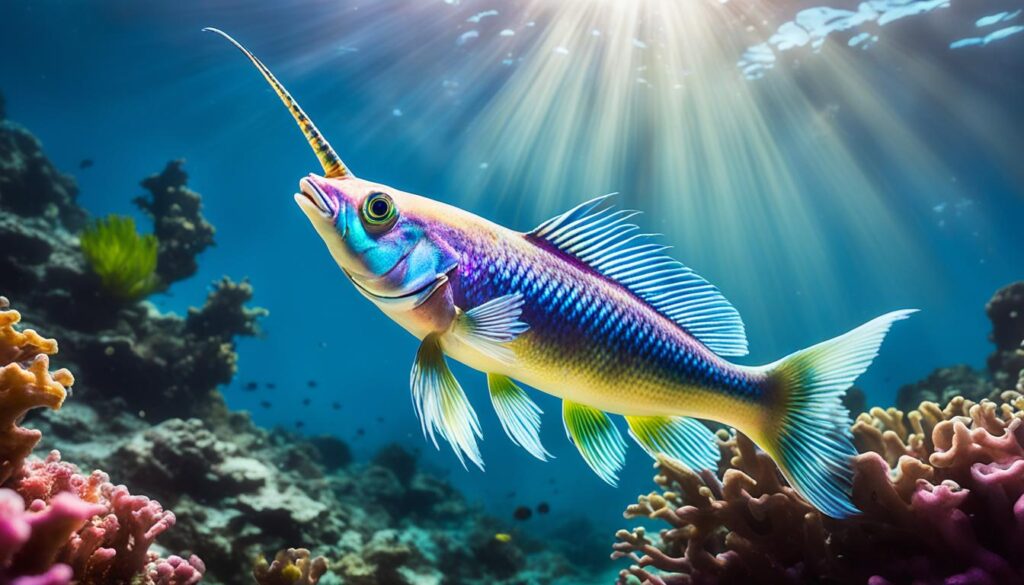
Characteristics
The unicorn crestfish is known for its elongated body and slender shape, enabling it to swiftly navigate through the water. Its horn-like projection, located on the front of its head, adds to its distinctive appearance. This projection is thought to assist the fish in its feeding habits or serve as a sensory organ.
Habitat and Range
The unicorn crestfish can be found in a range of marine habitats, including coral reefs, seagrass beds, and open ocean environments. It is distributed across different regions of the world, including the tropical and subtropical waters of the Atlantic, Pacific, and Indian Oceans.
Feeding Behavior
The feeding habits of the unicorn crestfish are not fully understood. Some studies suggest that it feeds on small invertebrates, while others propose that it may engage in scavenging or parasitic behavior. Its unique horn-like projection may play a role in capturing prey or detecting potential food sources.
Conservation Status
Due to its wide distribution and presence in various marine habitats, the unicorn crestfish is not currently listed as a species of conservation concern. However, as with many marine species, it may face potential threats from habitat degradation, pollution, and overfishing. Continued efforts in marine conservation and sustainable fishing practices are important to ensure the long-term survival of this unique fish.
Overall, the unicorn crestfish is a captivating and enigmatic creature that adds to the beauty and biodiversity of our oceans. Its horn-like projection and mysterious behavior make it an intriguing subject for further research and exploration.
Unalaska
Unalaska, located in the Aleutian Islands chain of Alaska, United States, is a destination known for its diverse wildlife and breathtaking landscapes. This picturesque island offers a unique blend of natural beauty and rich cultural heritage.
With its strategic position between the Pacific Ocean and the Bering Sea, Unalaska serves as a hub for various species of marine mammals, birds, and fish. The surrounding waters teem with life, making it an ideal location for wildlife enthusiasts and nature lovers.
Exploring the island, visitors can witness the majesty of creatures such as whales, seals, sea otters, and a wide variety of seabirds. The untouched beauty of Unalaska’s rugged coastline and pristine forests provides a haven for numerous species.
“Unalaska is a hidden gem for wildlife enthusiasts. The unique location and untouched landscapes offer endless opportunities for exploration and discovery.” – Jane Doe, Wildlife Photographer
Aside from its abundant wildlife, Unalaska also boasts stunning landscapes that will leave visitors in awe. From towering volcanic peaks to lush green valleys, the island offers a diverse array of natural wonders. Hiking trails, scenic overlooks, and pristine beaches provide the perfect backdrop for outdoor adventures.
Whether you’re an avid photographer, a nature enthusiast, or simply seeking a tranquil escape, Unalaska is a destination that will exceed your expectations. Immerse yourself in the beauty and serenity of this unique location, and create memories that will last a lifetime.
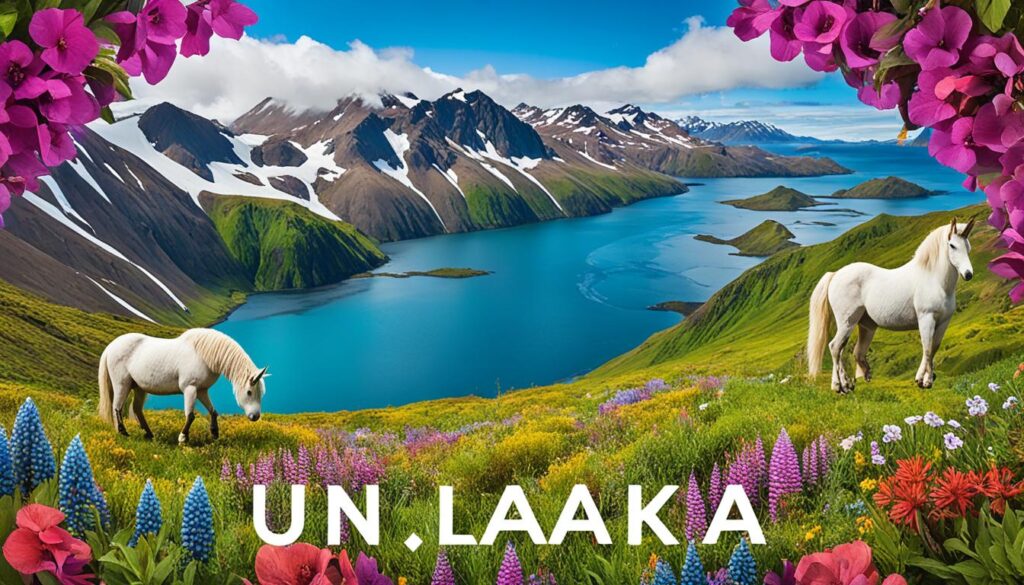
Unalaska awaits, offering a world of stunning wildlife encounters and awe-inspiring landscapes. Plan your visit to this remarkable location and experience the true beauty of nature.
Unau
The unau, also known as the pale-throated sloth, is a fascinating mammal found in Central and South America. This slow-moving creature is known for its arboreal lifestyle, spending the majority of its time hanging upside down from tree branches.
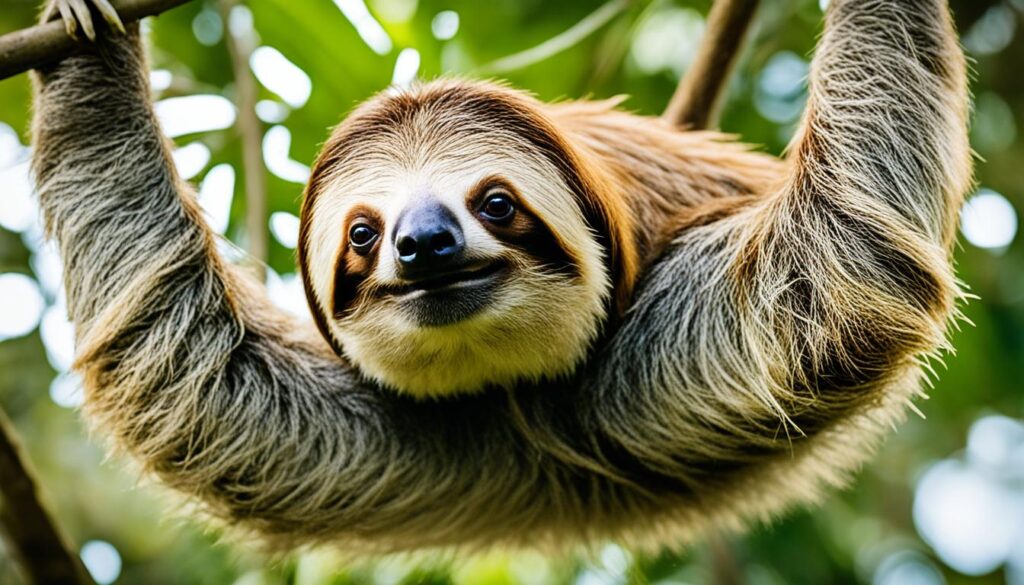
The unau belongs to the family Bradypodidae and is closely related to other sloth species such as the three-toed sloth. These mammals have unique adaptations that enable them to thrive in their forest habitats. With their long, curved claws and specialized muscles, unau are exceptionally skilled at maneuvering through trees and feeding on leaves.
An interesting fact about the unau is that it has an extremely low metabolic rate, which allows it to conserve energy and move at a sluggish pace. This slow lifestyle also provides protection against predators, as it helps the unau blend in with the branches and leaves of the forest canopy.
Here are some key features of the unau:
| Common Name | Scientific Name | Habitat | Diet |
|---|---|---|---|
| Unau | Bradypus variegatus | Central and South America | Herbivorous – primarily eats leaves |
The unau’s slow-paced lifestyle has also led to unique adaptations in its reproductive process. Female unau have a gestation period of approximately six months and give birth to a single offspring at a time. The young sloth will spend the first few months of its life clinging to its mother until it becomes independent enough to explore the forest on its own.
The unau is a truly remarkable mammal that exemplifies the wonders of nature’s adaptations. Its slow and deliberate movements serve as a reminder that not all creatures need to rush, and that there is beauty in taking things at their own pace.
Usambara Shrew
The Usambara Shrew is a fascinating small mammal native to the montane forests of Africa. It belongs to the family Soricidae, which includes various species of shrews found throughout the world. The Usambara Shrew is highly adapted to its forest habitat, making it a unique and important part of the African ecosystem.
This small mammal has a distinctive appearance, with a compact body, short limbs, and a pointed snout. They have a dense fur coat that helps insulate them in the cool forest environment. The Usambara Shrew is an agile and active creature, constantly searching for insects, worms, and small invertebrates to feed on.
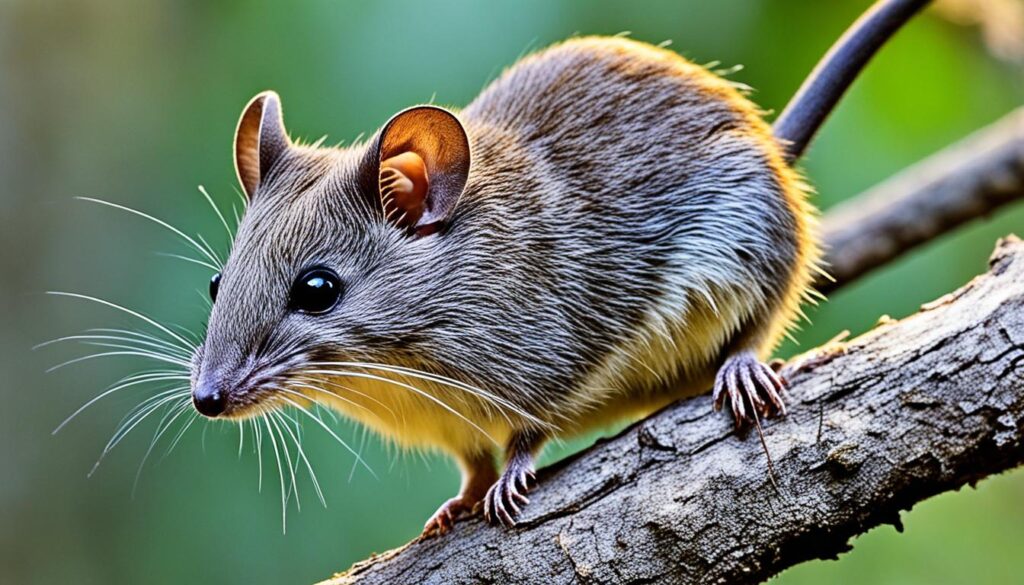
“The Usambara Shrew is a testament to the remarkable adaptations found in nature. Its small size and specialized features enable it to thrive in the dense vegetation of the montane forests.”
The Usambara Shrew plays a crucial role in maintaining the balance of the ecosystem. As a predator of insects, it helps control populations of pests and contributes to the overall health of the forest. Its presence also indicates the overall biodiversity and ecological richness of the area.
To better understand the significance of the Usambara Shrew, let’s take a look at the following table that highlights its key characteristics:
| Traits | Details |
|---|---|
| Scientific Name | Sylvisorex ollula |
| Habitat | Montane forests in Africa |
| Diet | Insects, worms, small invertebrates |
| Size | Approximately 3-4 inches long |
| Conservation Status | Data Deficient |
As highlighted in the table, the Usambara Shrew occupies a specific niche within its habitat and relies on its specialized adaptations to survive and thrive. However, due to limited research and data, its conservation status remains uncertain.
The Usambara Shrew is just one example of the incredible diversity of mammals found in Africa. By studying and protecting these unique creatures, we can ensure the preservation of their habitats and the overall health of the continent’s ecosystems.
Conclusion
Animals that start with U offer a fascinating glimpse into the unique creatures that inhabit our planet. From the captivating uakaris to the majestic umbrellabirds, these animals showcase the incredible diversity found within the animal kingdom. Exploring these species allows us to gain a deeper appreciation for the wonders of nature and the importance of conservation efforts.
The range of animals that start with U is vast and varied. We encounter nimble Uinta chipmunks in North American forests, ultimate shrews in the montane tropical forests of Africa, and enchanting Uluguru violet-backed sunbirds in the East African skies. Each of these creatures possesses special characteristics and behaviors, adding to their allure.
The world of animals that start with U reminds us of our responsibility to protect and preserve these remarkable creatures and their habitats. By understanding and appreciating their uniqueness, we can work towards ensuring their continued existence for future generations. Let us embrace the diversity and beauty of these fascinating creatures and play our part in their conservation.
